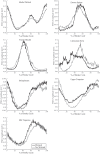Wearing a Wetsuit Alters Upper Extremity Motion during Simulated Surfboard Paddling
- PMID: 26551321
- PMCID: PMC4638342
- DOI: 10.1371/journal.pone.0142325
Wearing a Wetsuit Alters Upper Extremity Motion during Simulated Surfboard Paddling
Abstract
Surfers often wear wetsuits while paddling in the ocean. This neoprene covering may be beneficial to upper extremity movement by helping to improve proprioceptive acuity, or it may be detrimental by providing increased resistance. The purpose of this study was to evaluate the effects of wearing a wetsuit on muscle activation, upper extremity motion, heart rate, and oxygen consumption during simulated surfboard paddling in the laboratory. Twelve male, recreational surfers performed two paddling trials at a constant workload on a swim bench ergometer both with and without a wetsuit. Kinematic data and EMG were acquired from the right arm via motion capture, and oxygen consumption and heart rate were recorded with a metabolic cart and heart rate monitor. Wearing a wetsuit had no significant effect on oxygen consumption or heart rate. A significant increase in EMG activation was observed for the middle deltoid but not for any of the other shoulder muscle evaluated. Finally, approximate entropy and estimates of the maximum Lyapunov exponent increased significantly for vertical trajectory of the right wrist (i.e. stroke height) when a wetsuit was worn. These results suggest that a 2mm wetsuit has little effect on the energy cost of paddling at lower workloads but does affect arm motion. These changes may be the result of enhanced proprioceptive acuity due to mechanical compression from the wetsuit.
Conflict of interest statement
Figures





Similar articles
-
Characterisation of regional skin temperatures in recreational surfers wearing a 2-mm wetsuit.Ergonomics. 2018 May;61(5):729-735. doi: 10.1080/00140139.2017.1387291. Epub 2017 Oct 9. Ergonomics. 2018. PMID: 28962544
-
Increasing surfboard volume reduces energy expenditure during paddling.Ergonomics. 2017 Sep;60(9):1255-1260. doi: 10.1080/00140139.2016.1261188. Epub 2016 Nov 30. Ergonomics. 2017. PMID: 27875943 Clinical Trial.
-
Electromyographic Analysis of the Surf Paddling Stroke Across Multiple Intensities.J Strength Cond Res. 2019 Apr;33(4):1102-1110. doi: 10.1519/JSC.0000000000003070. J Strength Cond Res. 2019. PMID: 30741874
-
Physiological aspects of surfboard riding performance.Sports Med. 2005;35(1):55-70. doi: 10.2165/00007256-200535010-00005. Sports Med. 2005. PMID: 15651913 Review.
-
Shoulder muscle recruitment patterns and related biomechanics during upper extremity sports.Sports Med. 2009;39(7):569-90. doi: 10.2165/00007256-200939070-00004. Sports Med. 2009. PMID: 19530752 Review.
Cited by
-
The impact of a single surfing paddling cycle on fatigue and energy cost.Sci Rep. 2021 Feb 25;11(1):4566. doi: 10.1038/s41598-021-83900-y. Sci Rep. 2021. PMID: 33633202 Free PMC article.
-
Measurements of the hydrodynamic pressure on a surfboard fin during surfing.Sci Rep. 2025 Mar 25;15(1):10331. doi: 10.1038/s41598-025-94834-0. Sci Rep. 2025. PMID: 40133604 Free PMC article.
-
The Surfer's Shoulder: A Systematic Review of Current Literature and Potential Pathophysiological Explanations of Chronic Shoulder Complaints in Wave Surfers.Sports Med Open. 2021 Jan 6;7(1):2. doi: 10.1186/s40798-020-00289-0. Sports Med Open. 2021. PMID: 33409808 Free PMC article.
-
The effects of a land-based warm-up and accompanying passive heat retention on core body temperature, hormones, and subsequent performance in elite surfers.Front Sports Act Living. 2024 Oct 10;6:1458268. doi: 10.3389/fspor.2024.1458268. eCollection 2024. Front Sports Act Living. 2024. PMID: 39450117 Free PMC article.
References
-
- Riera F, Horr R, Xu X, Melin B, Regnard J, et al. (2014) Thermal and metabolic responses of military divers during a 6-hour static dive in cold water. Aviation, Space, & Environmental Medicine 85: 509–517. - PubMed
-
- Wakabayashi H, Hanai A, Yokoyama S, Nomura T (2006) Thermal insulation and body temperature wearing a thermal swimsuit during water immersion. Journal of Physiological Anthropology 25: 331–338. - PubMed
-
- Wakabayashi H, Kaneda K, Okura M, Nomura T (2007) Insulation and body temperature of prepubescent children wearing a thermal swimsuit during moderate-intensity water exercise. Journal of Physiological Anthropology 26: 179–183. - PubMed
-
- Tomikawa M, Nomura T (2009) Relationships between swim performance, maximal oxygen uptake and peak power output when wearing a wetsuit. Journal of Science in Medicine & Sport 12: 317–322. - PubMed
-
- Tomikawa M, Shimoyama Y, Nomura T (2008) Factors related to the advantageous effects of wearing a wetsuit during swimming at different submaximal velocity in triatheletes. Journal of Science and Medicine in Sport 11: 417–423. - PubMed
MeSH terms
LinkOut - more resources
Full Text Sources
Other Literature Sources

